
The John F. Kennedy Space Center, located on Merritt Island, Florida, is one of the National Aeronautics and Space Administration's (NASA) ten field centers. Since December 1968, KSC has been NASA's primary launch center of human spaceflight. Launch operations for the Apollo, Skylab and Space Shuttle programs were carried out from Kennedy Space Center Launch Complex 39 and managed by KSC. Located on the east coast of Florida, KSC is adjacent to Cape Canaveral Space Force Station (CCSFS). The management of the two entities work very closely together, share resources and operate facilities on each other's property.

The Aerobee rocket was one of the United States' most produced and productive sounding rockets. Developed by the Aerojet Corporation, the Aerobee was designed to combine the altitude and launching capability of the V-2 with the cost effectiveness and mass production of the WAC Corporal. More than 1000 Aerobees were launched between 1947 and 1985, returning vast amounts of astronomical, physical, aeronomical, and biomedical data.

Cape Canaveral Space Force Station (CCSFS) is an installation of the United States Space Force's Space Launch Delta 45, located on Cape Canaveral in Brevard County, Florida.

Saturn-Apollo 3 (SA-3) was the third flight of the Saturn I launch vehicle, the second flight of Project Highwater, and part of the American Apollo program. The rocket was launched on November 16, 1962, from Cape Canaveral, Florida.
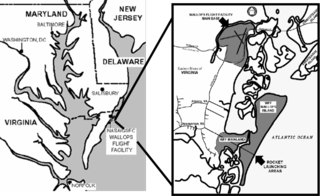
Wallops Flight Facility (WFF) is a rocket launch site on Wallops Island on the Eastern Shore of Virginia, United States, just east of the Delmarva Peninsula and approximately 100 miles (160 km) north-northeast of Norfolk. The facility is operated by the Goddard Space Flight Center in Greenbelt, Maryland, and primarily serves to support science and exploration missions for NASA and other Federal agencies. WFF includes an extensively instrumented range to support launches of more than a dozen types of sounding rockets; small expendable suborbital and orbital rockets; high-altitude balloon flights carrying scientific instruments for atmospheric and astronomical research; and, using its Research Airport, flight tests of aeronautical research aircraft, including unmanned aerial vehicles.

The Thor-Able was an American expendable launch system and sounding rocket used for a series of re-entry vehicle tests and satellite launches between 1958 and 1960. It was a two-stage rocket, consisting of a Thor IRBM as a first stage and a Vanguard-derived Able second stage. On some flights, an Altair solid rocket motor was added as a third stage. It was a member of the Thor family and an early predecessor of the Delta.

The Atlas-Centaur was a United States expendable launch vehicle derived from the SM-65 Atlas D missile. Launches were conducted from Launch Complex 36 at the Cape Canaveral Air Force Station (CCAFS) in Florida.

The WAC Corporal was the first sounding rocket developed in the United States and the first vehicle to achieve hypersonic speeds. It was an offshoot of the Corporal program, that was started by a partnership between the United States Army Ordnance Corps and the California Institute of Technology in June 1944 with the ultimate goal of developing a military ballistic missile.

Launch Complex 39 (LC-39) is a rocket launch site at the John F. Kennedy Space Center on Merritt Island in Florida, United States. The site and its collection of facilities were originally built as the Apollo program's "Moonport" and later modified for the Space Shuttle program.
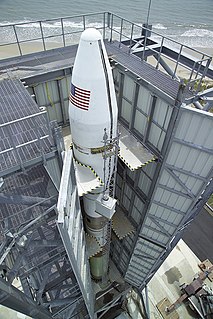
The Minotaur is a family of United States solid fuel launch vehicles derived from converted Minuteman and Peacekeeper intercontinental ballistic missiles (ICBM). They are built by Northrop Grumman via contract with the Air Force Space and Missile Systems Center's Space Development and Test Directorate (SMC/SD) as part of the Air Force's Rocket Systems Launch Program which converts retired Intercontinental Ballistic Missiles into space and test launch systems for U.S. government agencies.
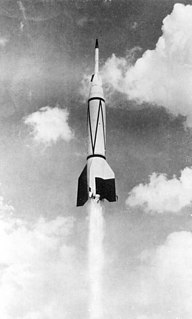
The RTV-G-4 Bumper was a sounding rocket built by the United States. A combination of the German V-2 rocket and the WAC Corporal sounding rocket, it was used to study problems pertaining to two-stage high-speed rockets. The Bumper program launched eight rockets between May 13, 1948, to July 29, 1950. The first six flights were conducted at the White Sands Missile Range, the seventh launch, Bumper 8 on July 24, 1950, was the first rocket launched from Cape Canaveral.

A rocket garden is a display of missiles, sounding rockets, or space launch vehicles usually in an outdoor setting. The proper form of the term usually refers to the Rocket Garden at the Kennedy Space Center Visitor Complex.
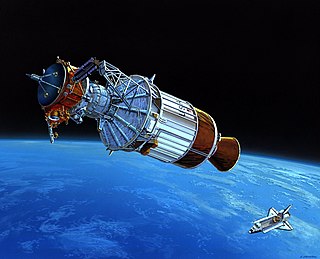
The Inertial Upper Stage (IUS), originally designated the Interim Upper Stage, was a two-stage, solid-fueled space launch system developed by Boeing for the United States Air Force beginning in 1976 for raising payloads from low Earth orbit to higher orbits or interplanetary trajectories following launch aboard a Titan 34D or Titan IV rocket as its upper stage, or from the payload bay of the Space Shuttle as a space tug.
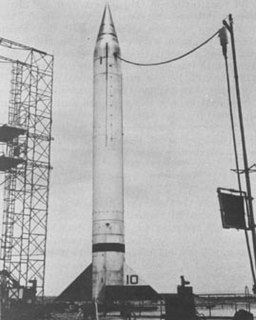
The year 1954 saw the conception of Project Orbiter, the first practicable satellite launching project, utilizing the Redstone, a newly developed Short Range Ballistic Missile.
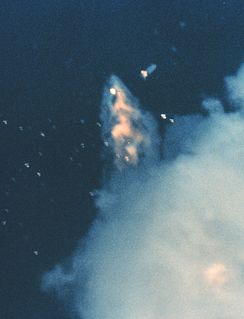
In the field of rocketry, range safety may be assured by a system which is intended to protect people and assets on both the rocket range and downrange in cases when a launch vehicle might endanger them. For a rocket deemed to be off course, range safety may be implemented by something as simple as commanding the rocket to shut down the propulsion system or by something as sophisticated as an independent Flight Termination System (FTS), which has redundant transceivers in the launch vehicle that can receive a command to self-destruct then set off charges in the launch vehicle to combust the rocket propellants at altitude. Not all national space programs use flight termination systems on launch vehicles.

The Delta L, Thor-Delta L, or Thrust-Augmented Long Tank Thor-Delta was a US expendable launch system used to launch the Pioneer E and TETR satellites in 1969 (failed) and HEOS satellite in 1972. It was a member of the Delta family of rockets.

The NASA Railroad is a Class III industrial short-line railroad at the Kennedy Space Center in Cape Canaveral, Florida. The railroad consists of 38 miles (61 km) of track connecting the mainline of the Florida East Coast Railway and trackage at the Cape Canaveral Space Force Station. NASA uses the railroad to deliver large or bulk materials to support its operations, particularly solid rocket boosters and chemicals such as helium and oxygen for rocket fuel.
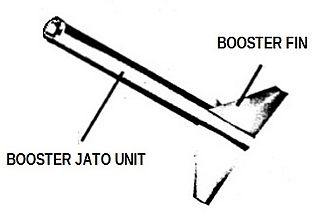
The Nike stage or Nike booster, a solid fuel rocket motor, was created by Hercules Aerospace for the Nike Ajax (M5) Nike Hercules (M5E1). It was developed for use as the first stage of the Nike Ajax and Nike Hercules missiles as part of Project Nike.

Falcon 9 Full Thrust is a partially reusable medium-lift launch vehicle, designed and manufactured by SpaceX. Designed in 2014–2015, Falcon 9 Full Thrust began launch operations in December 2015. As of 5 September 2022, Falcon 9 Full Thrust had performed 154 launches without any failures. Based on the Lewis point estimate of reliability, this rocket is the most reliable orbital launch vehicle currently in operation.

Beacon was one of America's first satellite programs. A balloon satellite, its objective was to study atmospheric density at its orbital altitude and to be the first United States satellite visible to the naked eye. Booster problems caused both orbital attempts to end in failure.




















